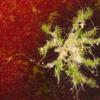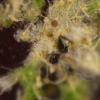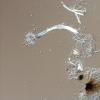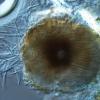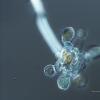
18-07-2025 23:03
Hello.Fruitings between 51 and 130 microns in tota

16-07-2025 17:34
 Bernard Declercq
Bernard Declercq
Hello,I have trouble distinguishing above mention

14-07-2025 11:20
 Michel Hairaud
Michel Hairaud
Bonjour, Voici une espèce de (?) Hyaloscyphace

16-01-2023 21:31
 Riet van Oosten
Riet van Oosten
Hello, Nearby the find of Calycina claroflava on

14-07-2025 17:55
Yanick BOULANGERBonjourAutre dossier laissé en suspendJe viens de

14-07-2025 11:17
Yanick BOULANGERBonjourJ'ai un dossier Jackrogersella qui est rest

14-07-2025 15:52
Gernot FriebesHi,I wanted to share this collection on Rubus idae

14-07-2025 13:37
Gernot FriebesHi,do you think this collection could be R. ulmari
 Hello! I wanted to share a fascinating thing I saw this week. This is the coelomycete anamorph state of pyrenolichen Phyllocharis orbicularis (=Strigula orbicularis), which is apparently not illustrated anywhere. I was lucky enough to be able to ask Robert Lücking for help, and he ID'd it right away, having seen it before; when I asked where I could find an illustration, he admitted that he didn't think one existed, only the ascomata and the macromorphology of the thallus. The thallus of this particular example is somewhat poorly lichenized, and looks more like the photobiont (Cephaleuros virescens) than the typical thallus, but the conidia are the really fun part anyway.
Hello! I wanted to share a fascinating thing I saw this week. This is the coelomycete anamorph state of pyrenolichen Phyllocharis orbicularis (=Strigula orbicularis), which is apparently not illustrated anywhere. I was lucky enough to be able to ask Robert Lücking for help, and he ID'd it right away, having seen it before; when I asked where I could find an illustration, he admitted that he didn't think one existed, only the ascomata and the macromorphology of the thallus. The thallus of this particular example is somewhat poorly lichenized, and looks more like the photobiont (Cephaleuros virescens) than the typical thallus, but the conidia are the really fun part anyway.The conidia are hyaline, 4- to 6-septate, 40-45 x 2-3.5 ?m excluding the appendages, with a non-cellular, mucoid appendage at each end, which are quite variable in length, but generally less than 10 ?m, and often curving into a hook. Conidiophores are small, lageniform, reduced to conidiogenous cells, and integrated into the inner wall of the pycnidium.
I really wanted to put these photos out there, so that if anyone else is struggling to identify this beautiful and distinctive anamorph they'll be able to find some reference images! I can't thank Dr. Lücking enough for his kind help in the identification of this fungus.

